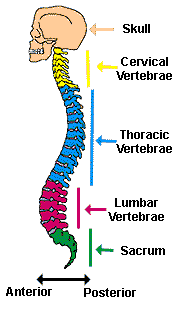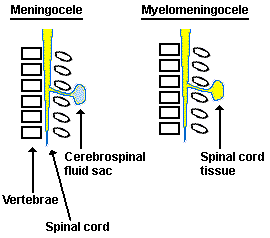 | Fetal Surgery for Spina Bifida |  |
 | Fetal Surgery for Spina Bifida |  |
| November 18, 1999 (updated April 8, 2020) Spina bifida is a relatively common birth defect that affects 1,500-2,000 babies born in the United States each year. "Spina bifida" literally means "split spine"; it is caused by failure of the spinal cord to develop properly. The nervous system develops from embryonic tissue called the ectoderm. The first sign of the developing nervous system is the neural plate which can be seen at about the 16th day of development. Over the next few days, a "trench" is formed in the neural plate - this creates a neural groove. By the 21st day of development, a neural tube is formed when the edges of the neural groove meet. The rostral (front) part of the neural tubes goes on to develop into the brain and the rest of the neural tube develops into the spinal cord. Spina bifida occurs when the neural tube is not formed properly; the bones of spinal column (the vertebrae) and muscle fail surround the spinal cord properly. No one knows exactly what causes spina bifida, but it is thought that both environmental and genetic factors play a role.
 Development of the Nervous System |
 Skull and Vertebrae |
 Failure of the neural tube to develop properly may result in
three different conditions that lead to spina bifida: Failure of the neural tube to develop properly may result in
three different conditions that lead to spina bifida:
In both a meningocele and a myelomeningocele, a small sac that bulges out of the baby's back can be seen. Babies born with spina bifida may have nerve damage that can cause paralysis, bladder and bowel problems, and limb and spine disorders. Leakage of cerebrospinal fluid from the defect in the spinal cord may cause the brain to bulge out near the cerebellum. This may block the flow of cerebrospinal fluid and result in hydrocephalus. Babies with spina bifida usually have surgery within the first 24 to 48 hours after birth to repair the spinal cord and brain. Sometimes a shunt is placed in the baby's head to drain away excess fluid and reduce pressure on the brain caused by hydrocephalus.
Fetal surgery for spina bifida still has risks. Fetal surgery appears to increase the chance of premature birth and mothers may develop complications such as rupturing of the uterus and bowel obstruction. Because this type of fetal surgery is not performed very often, some physicians view the procedure as experimental. Nevertheless, these pioneering studies may lead to other ways that improve the quality of life for babies born with spina bifida. |
|
References and further information:
|
| BACK TO: | Neuroscience In The News | Neurological and Mental Disorders | Table of Contents |
![[email]](./gif/menue.gif) Send E-mail |
![[newsletter]](./gif/menunew.gif) Get Newsletter |
![[search]](./gif/menusea.gif) Search Pages |